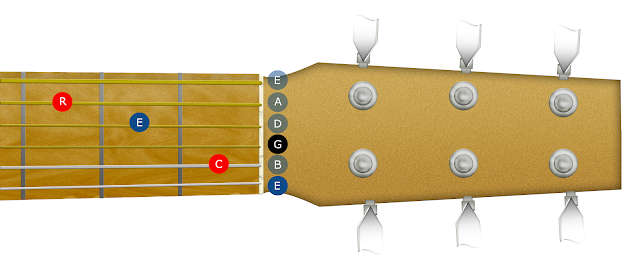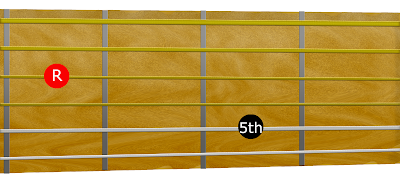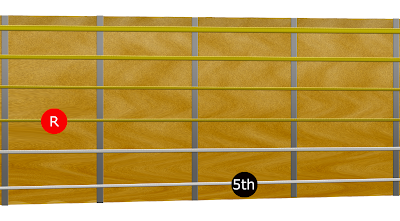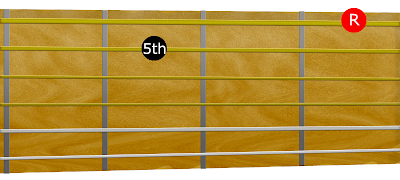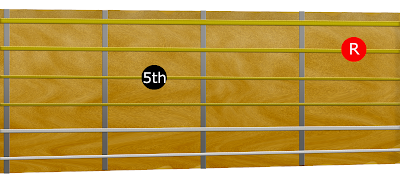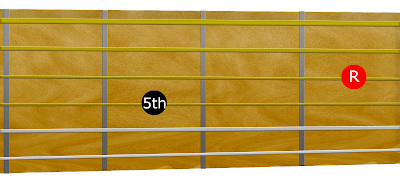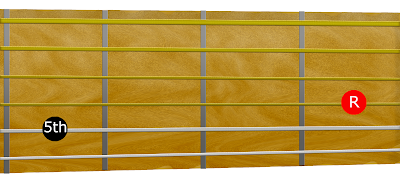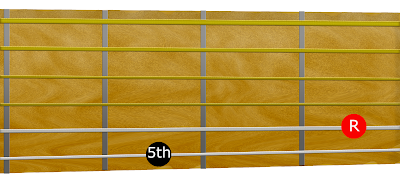In the previous lesson, we’ve looked at playing the root note (or tonic) along with a third interval harmony.
This next lesson will be in two parts and we’ll look at adding the fifth interval note to build a full major chord. Remember, that’s how all chords are built, based on the first (or root note), major third interval note, and perfect fifth interval note of a scale.
In part a of this lesson, I’ll teach you how to find fifth interval notes in relation to your root notes.
In part b of, you’ll have a go at playing fifth intervals by using power chords.
Building a C chord with a third and fifth interval note
Let’s start part one of our lesson on fifth interval notes by looking at the C chord. To build a C chord, we take the first, third and perfect fifth interval notes from the C scale. So we spell the C chord as C, E, and G.
C - Tonic (or root note)
C# - Flat 2nd
D - Second
D# Flat 3rd
E - 3rd
F Perfect 4th
F# - Flat 5th
G - Perfect 5th
G# - Flat 6th
A - 6th
A# - Flat 7th
B - 7th
The root note of the C chord is on the 5th string (the A string). So, walking down the fifth string (second thickest), you have A in the open position, A#, B, and C - it’s on the third fret.
Next, we know from our previous lesson on thirds intervals, that the E note, is going to be one string below our root note , and a half step up the neck towards the nut.
Now we need to locate the perfect fifth note in the C scale to turn this harmony into a complete chord. The perfect fifth interval note in the C scale is the G - so we need to find a G note to complete our chord.
We already have notes on the fifth and fourth strings, so we know our G note, will be on one of the strings below this - on the first string, the second string, or the third string.
We also know, from one of our first sessions, that the third string (open) is a G.
That’s one of the notes in the C scale, so that will fit.
The next string though is the open B, so we can play another root note here and make that a C as well.
Let’s look at this in more detail:
So, each string of the guitar is playing either the first, third, or fifth notes of the scale (C, E, or G).
Why don't you play the E string in a C chord on guitar
Notice that we don’t play the sixth string (the low E note), even though it’s in key.
Now that string, played open would give us an E note, and E is the third interval of the C scale. It’s in key, so why don’t we play it? Well, this is because we want the C to be our root note, the dominant sound that we want to hear when we play it. It’s going to be a tonal centre of our song, like a home base that the song will want to resolve back to.
So, if you want to find the fifth interval note, of any root note, here’s the rule one.
The fifth interval note can be found two strings down, and three frets across from the root note.
And that’s a moveable shape too, on this pair of strings.
Let's look at the fifth interval shapes that you need to be familiar with, to find your fifth interval note anywhere on the fretboard:
When the 5th interval lands on the B string, remember to move it by a semitone because the B string is tuned to an interval of a major third, not an interval of a perfect fourth:
A second way to find a fifth interval on guitar
Now, there’s a second way to find a fifth interval note too.
Remember how we learned that the perfect fourth is usually underneath our root note? Well if that’s the case, we know we can find a fifth interval two frets to the right of this (on a right handed guitar). So we also have a fifth interval note here too.
It’s important to know how to find these interval notes to the left and right of your root note. If I’m playing my root note with my little finger, for example, I want a fifth interval note to my left because that’s the side my free fingers are on.
If I play that same root note with my index finger, I want to find a fifth interval note to the right, because that’s the side my free fingers are on! You may recognise these as power chord shapes, which we'll go on to look at in more detail in part b of this lesson.
The C chord and the C shape on guitar
Now, we’ve just built a C shaped chord by identifying where our one, three, and five notes are.
You might have recognised this as a C chord, and it is a C chord. However, I want you to remember to refer to this as a C shape, rather than a C chord.
The reason for this is because regardless of where we move these notes to, on these particular strings, as long as the intervals stay in the same places, we can play a range of different chords. For example, if I move everything up a whole step, I’m playing a D chord.
Failing to understand this is the reason that a lot of guitarists get stuck playing in this first position and are unsure how to play higher up the fretboard - because that idea of a chord shape becomes fixed with the chord name when it’s played in a particular position.
All chord shapes are moveable. So we need to separate the idea of the chord shape, and the chord names.
There’s also a second method for identifying fifth intervals on the guitar, and this is related to the concept of power chords, which is covered in part b of this lesson.
Go to Lesson 6, part b: Finding fith intervals with power chords
Guitar practice journal
Download the Guitar Practice Tracker today. It will help to keep you motivated and give you a visual representation of your progress, and areas of focus throughout the year.
A guitar journal will enable you to:- Set personalised goals and monitor your progress
- Identify the number of hours or days you've spent on a particular skill
- Provide a quick reference to the notes and chords in a particuar key
- List the songs you know and sort by key, capo placement, artist, and chord progression
- Link directly to your favourite YouTube videos and tutorials
Download the Guitar Practice Tracker
If you enjoyed this free lesson, and you're able to, please
Photo by Wendy Wei

